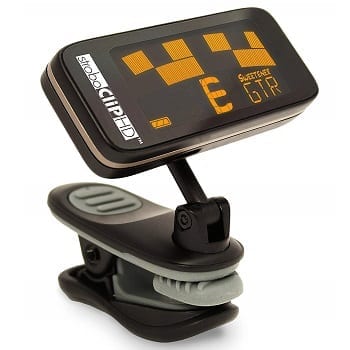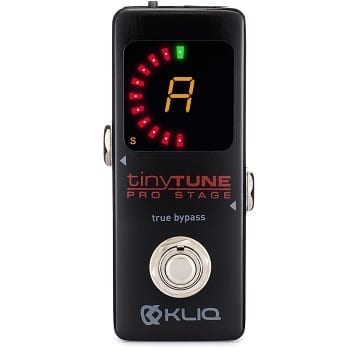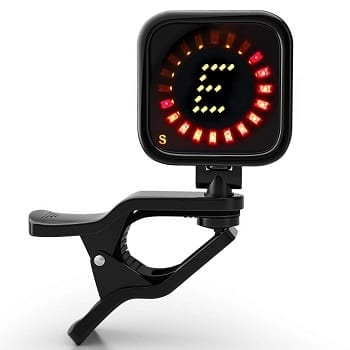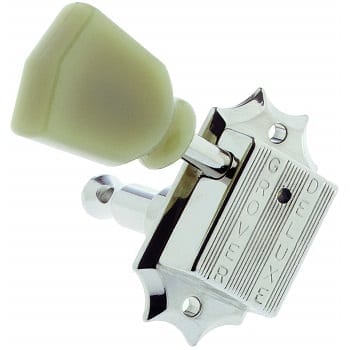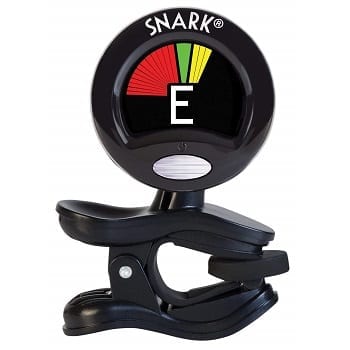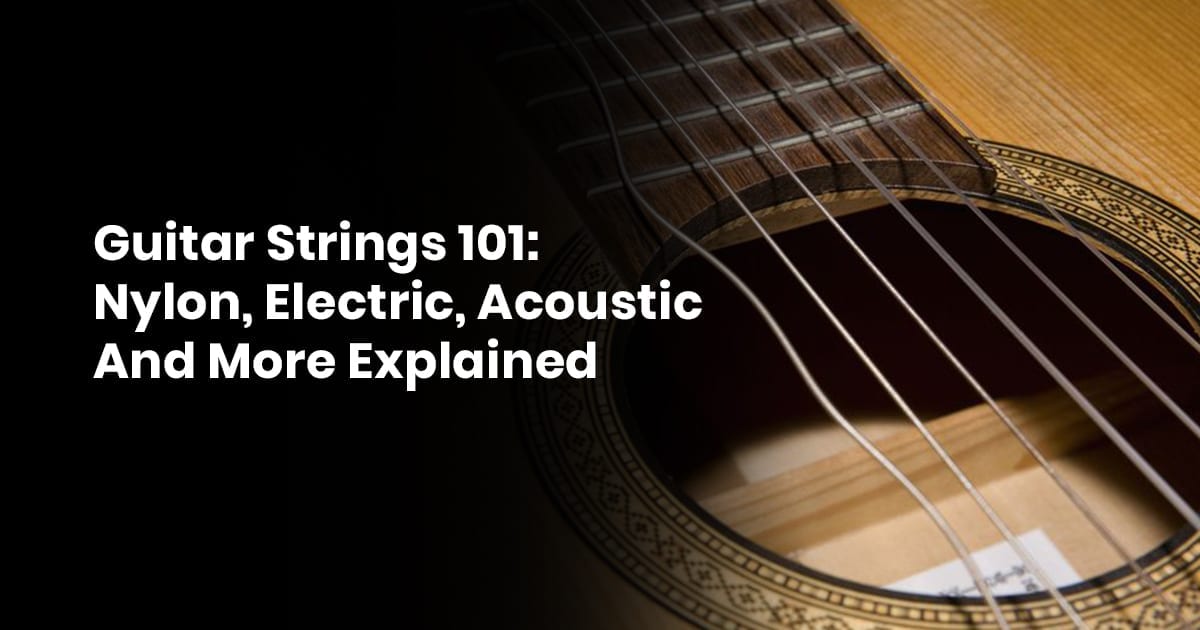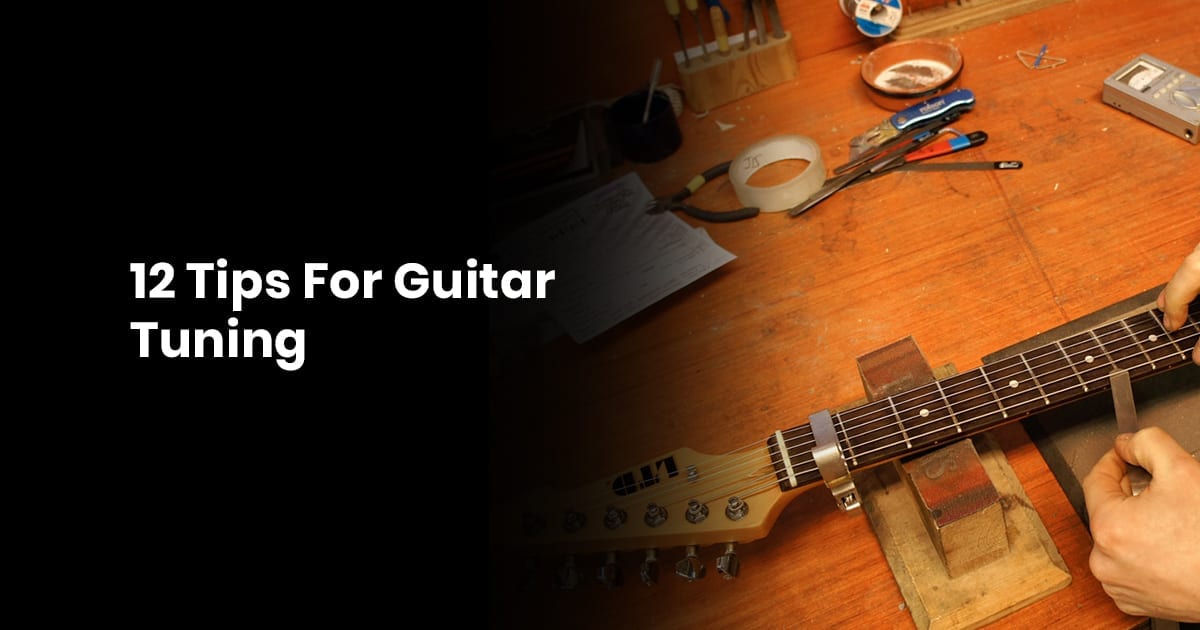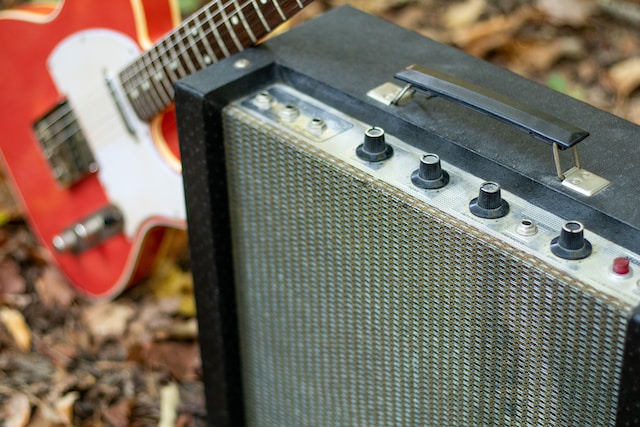[amazon table=”840″]
Regardless of how good your guitar is, and no matter how good your playing ability, if your guitar isn’t tuned, you’re going to be disappointed with the sound produced.
That makes tuning the key to guitar playing success.
Fortunately, there are a range of very good electronic and manual tuners on the market that take all the pain out tuning.
In this article, we discover the 5 best tuners for acoustic, electric and classical guitars on the current market.
We’ll not only uncover the best overall, but also the best value tuner of 2022.
Our Reviews Of The Best Guitar Tuners
Benefits
The Peterson StroboClip HD Clip-On Tuner is an extremely accurate tuner that features a new, large, high definition, high contrast screen.
A huge benefit of this tuner is the addition of 50+ sweeteners so you can use it for different types of instruments.
Drawbacks
There are no actual negatives that we could find.
The only potential drawback is that this is strobe type tuner which may take a little getting used to for newbies.
Extra Features
The accuracy of this tuner is quite simply outstanding, to a level of 0.1 cent.
That an accuracy level of 1/1000th of semitone. This makes it the most accurate guitar tuner out there.
The 50 sweeteners not only allow you to tune a range of different instruments. They will also allow you to correct all manner of inherent tuning issues.
This chromatic tuner also allows for drop tuning and capo settings.
A large, powerful rubber covered clamp allows you to attach the tuner to your headstock without fear of it coming off or of scratching your instrument.
This updated version of the Peterson Stroboclip tuner has an improved power button and a quick navigation menu.
Buying Advice
The Peterson Stroboclip HD Clip-On Tuner is a fantastic guitar tuner.
It’s twice the price of some other market offerings but, if you can make way for the extra expense, you will be very glad for that extra investment.
It is easily the best tuner that we came across!
Technical specifications
- Type: Clip-on / Electric
- Size: 2.37 x 1 x 1.75 in
- Weight: 1.28 oz
- Best For: Acoustic, Classical Guitars
Benefits
The KLIQ TinyTune Pro Stage Tuner Pedal is an extremely accurate pedal tuner that features true bypass switching, strong metal housing and a bright, easy to read display.
The controls are all easily accessible on the front of the box. You can tune to a range of frequencies from A0 to C8.
The reference pitch can also be adjusted between 430 and 450 hz.
Drawbacks
The KLIQ Tiny Tune Pro Stage Tuning Pedal does a great job of tuning the A, D and G strings, but is not quite as accurate when it comes to the lower E and B strings.
Extra Features
The compact size of this tuner pedal makes it unobtrusive and convenient.
However, it still provides you with a clear, easy to read screen. You’ll even be able to see it clearly in bright sunlight.
This is an easy to use tuner that displays the letter of the note that you are tuning.
An easy to follow system of bars and arrows lets you know if you need to tune up or down.
Buying Advice
The KLIQ Tiny Tune Pro Stage Tuning Pedal is smaller than most but still delivers in terms of accuracy, ease of use and display quality.
This is one of the best bass guitar tuners out there.
Technical specifications
- Type: Pedal / Electric
- Size: 3.7 x 1.2 x 1.5 in
- Weight: 5.1 oz
- Best For: Acoustic / Electric Guitars
Benefits
The Crescendo ZenStrobe TRUE STROBE Clip On Tune is a chromatic clip on tuner that provides a level of accuracy that is very nearly on par with the Peterson Stroboclip HD Clip-On Tuner.
The mount on this tuner is extremely rugged, ensuring that it delivers a secure mount. It also provides you with a bright, easy to read display.
You get a 3-year warranty with this product, which is extremely impressive in comparison to the market competition.
Drawbacks
Turning the Crescendo Zen Strobe Tuner on and off takes quite long press of the on-off button.
Furthermore, the buttons are a little small and tricky to use, especially for guys with big hands!
Extra Features
The Crescendo Zen Strobe Tuner features auto-shutoff, which saves battery life.
You also get 360 degree rotation to allow for full flexibility. It can also be placed on both the front and rear headstock.
This tuner can be used with a wide range of instruments, including violin, banjo and trumpet.
Buying Advice
The Crescendo Zen Strobe Tuner is an impressively accurate tuner that is compact and attaches sturdily to your guitar and will not scratch your instrument in the process.
It is a mid range price tuner that comes with an impressive warranty, so you can buy with confidence.
Technical specifications
- Type: Clip-on / Electric
- Size: 5.6 x 2.9 x 2.2 in
- Weight: 3.2 oz
- Best For: Acoustic / Electric Guitar
Benefits
The Grover 135N Guitar Tuner is a vintage style tuning machine head.
It has a gear ratio of 14:1 and housing that affords optimal worm, string and gear post bearings.
Drawbacks
The Grover 135N Guitar Tuner is a manual tuning kit. This requires quite a learning curve in comparison to electronic tuners.
Extra Features
The precision cut worm and gear provide ideal meshing, eliminating the potential for string slippage.
The Grover 135N Guitar Tuner comes in a set of six vintage-style guitar machine heads and includes washers, bushings and screws.
The heads have a chrome finish and Grover offers a lifetime no-fault warranty.
Buying Advice
The Grover 135N Guitar Tuner is a manual tuner that comes in a set of six, providing good value for money.
However, if you’re a beginner you will probably want to stick with an electric tuner, which is far more user friendly.
Technical specifications
- Type: Manual
- Size: 9 x 4.8 x 1.8 in
- Weight: 3.52 oz
- Best For: Acoustic / Classical Guitars
Benefits
The Snark SN5X Clip-On Tuner for Guitar is an upgrade of Snark’s original model.
This Amazon best seller has an enhanced display which allows you to easily view the display from every angle.
It has a newly redesigned processing chip, making tuning faster and more accurate than on the previous model.
Drawbacks
The plastic housing of this unit is not very high quality.
Extra Features
High definition display and a swivel head allows you to turn the tuner to all angles for ease of viewing.
The clip is tight and accurate. It also has a tap tempo metronome.
Buying Advice
The Snark SN5X Clip-On Tuner is a functional, easy to use tuner that gives you a good, not very precise reading.
It can be used on guitar, bass and violin making it more limited than many competitors.
However, this is an extremely well priced unit. It is a great investment for novice guitar users.
Technical specifications
- Type: Clip-on / Electric
- Size: 1.8 x 1.8 x 3.5 in
- Weight: 1.6 oz
- Best For: Acoustic / electric Guitars
Guitar Tuner Buying Advice
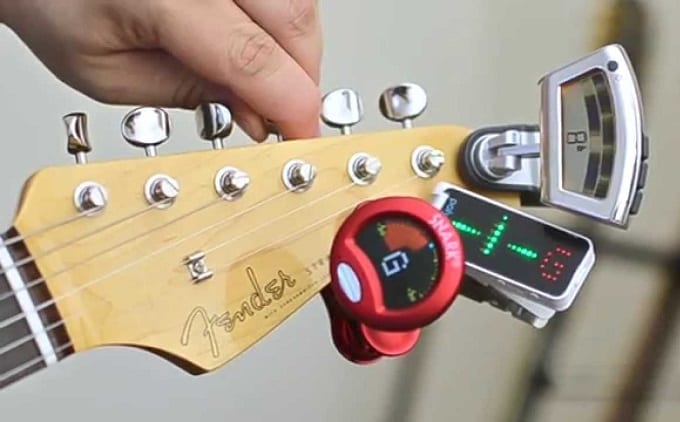
The first buying decision you will face is whether to buy a chromatic or a non-chromatic tuner.
Our suggestion is to go with a non-chromatic tuner unless you are going to be tuning unconventional notes.
When it comes to price, there is a wide fluctuation. Obviously the quality improves with the price.
You need to ensure that the readout on the tuner is easy to read. Think about whether or not you’ll be playing outside.
If so, you might not be able to see an LED display very clearly. On the other hand, if you’re playing inside in the dark, an LED display will be ideal.
In preference to an LED display, you can get a display which features a needle indicator. It may also have a color code to indicate whether the note is sharp or flat.
There is no best choice – it depends on your personal preference and the type of environment you will be playing in.
The majority of guitar tuners will be able to be used on any type of guitar.
However, if you are going to be playing heavy metal, you’ll want to use a tuner that allow you to do ‘drop tuning.’
The latest, high tech tuners will feature what is known as polyphonic tuning.
This will allow you to tune all six strings at once by strumming a single string. This feature will push the price up, but it’s a pretty cool feature!
More advanced tuners will allow you to change the temperament settings of the guitar. This relates to the way that notes are tuned in relation to one another.
That will ensure that the sound will be in tune with every key.
Beginners should buy a tuner that features a metronome. An additional feature that you can get with a pedal tuner is bypass / silent tuning.
This allows you to tune the guitar with no sound being involved in the process at all.
Guitar Tuner FAQ
Why is it important to Tune Your Guitar?
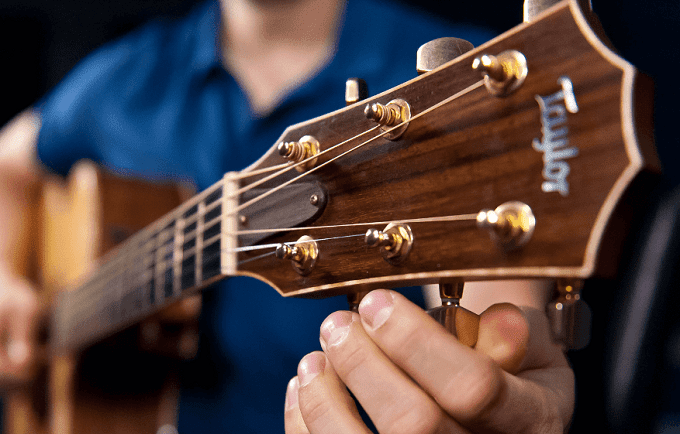
The sound produced by your guitar depends to a very large extent on the degree to which it is tuned.
You can be the best guitar player in town but, if the instrument is not in tune, you will produce nothing pleasant.
One of the key skills you can acquire when learning to play the guitar is to develop the skill of tuning the instrument.
When two strings are out of tune, they will vibrate at different rates. This will produce a ‘warbly’ vibration which is very off-putting.
How does a clip-on guitar tuner work?
A clip on guitar tuner has a built-in contact microphone. This microphone is extremely powerful to enable it to pick up tiny vibrations.
The tuner is clipped onto the headstock of the guitar. It is able to pick up the pitch of each string as a result of the instrument’s vibrations.
Clip on tuners are popular as a result of their compactness and ease of use.
Because it does its job s a result of the vibrations produced, clip-on guitar tuners can be used in noisy environments, which is another huge plus.
How Does a Guitar Tuner Work?
Guitar tuners do their work by recognizing and responding to the frequency that is produced.
Frequency and pitch are closely related – when frequency is either high or low, so is the pitch.
So, what is frequency?
It is the number of wave peaks that travel past a fixed point in a certain period of time.
Frequency is measured in Hertz (hz). It measures the number of wave crests that pass a certain point in one second.
The great thing about tuning by frequency is that notes are set at specific frequencies. That means that there is no guesswork, or having to rely on your ear.
Your guitar will do all the work for you and tell you whether or not the string is in tune.
If the frequency is either too high or too low, the tuner will tell you that it is either a bit sharp or a bit flat.
To use a tuner you should attach it to the guitar. Then play an open note on just one string. Then give time for the tuner to pick up the frequency.
The guitar tuner will register that the string is in tune if the frequency registered matches the set frequency for that note.
If heh frequencies do not match, the tuner will tell you whether the note is sharp or flat. All you then need to do is to either sharpen or loosen the string.
Then play the note again and check the reading to see if it registers that it is now in tune. You may have to make two or three adjustments to get the string in tune.
As a side-note, keep in mind that you need to have your electric guitar plugged in for the microphone on your tuner to pick up the frequency.
What does 440 mean on a guitar tuner?
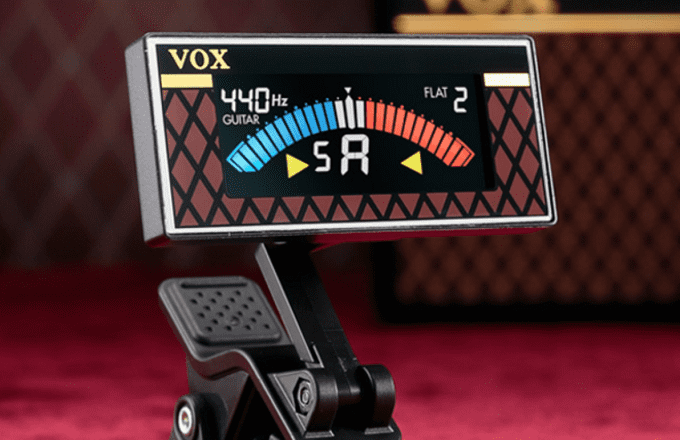
The number 440 on your tuner refers to the frequency of the A note, above middle C, which when ideally tuned is 440 hz.
A tuner will allow you to tune the A note between 435 hz and 445 hz.
Do you need a guitar tuner?
The answer is ‘no’, you do not need a tuner, but it will make your life extremely easier, especially if you are a beginner to the world of guitars.
A tuner will tell you definitively whether or not the tuner is in tune. If you don’t have a tuner you will have to rely on your own guess work and experience.
Of course, if you are a guitar novice, you will have no experience to draw upon.
The other great benefit of using a tuner is that you won’t have to do the tuning in a quiet environment because tuners rely on frequency rather than sound.
That can make a whole world of difference, especially if you are tuning your guitar between sets of a gig!
How often to tune your guitar?
It is a good habit to get into the habit of tuning your guitar every time you play it.
Of course, if you are playing it over several different intervals over the course of the day, you only need to tune it once at the start of your playing time.
Some experts may suggest tuning less frequently. However, guitars are notorious for getting out of tune very quickly.
With the help of a tuner, the tuning process is extremely painless and can be done in just a few minutes.
Taking that time, could well be the difference between getting a great and disappointing sound out of your instrument.
What is the difference between a chromatic tuner and a guitar tuner?
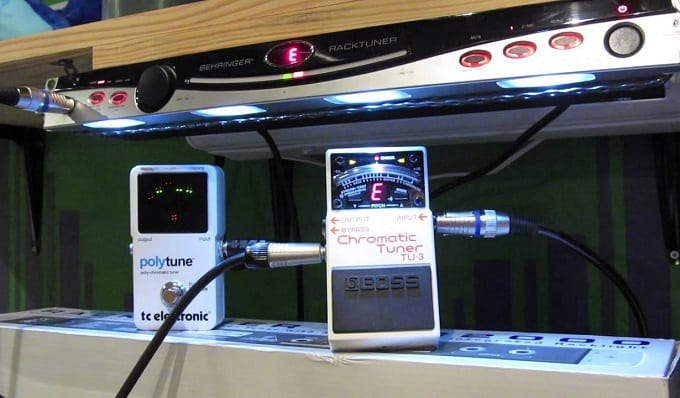
A chromatic tuner will ‘read’ the note that you play and tell you whether it is in tune or not. You can then tune the string up or down as required.
A guitar tuner has a switch on it which has a switch that you are required to preset to the desired note.
However guitar tuners will only allow you to pre-set the strings to E A D G (B E).
This is fine with basic notes, but when you want to tune to an odd note, such as ‘Eb’, you will find great difficulty.
Chromatic tuners are more expensive than guitar tuners but the extra cost will pay off in ease of use, especially when tuning to notes that are out of the norm.
What is the best tuner for a beginner to buy?
Novice guitarists should buy an electronic tuner. You can pick up a decent tuner for less than twenty bucks.
Be sure that the tuner that you purchase has an off-note indicator. This is handy because it will let you know which way to tune the string if it is out of tune.
As a beginner, you probably won’t need to go to the extra expense of buying a chromatic tuner.
The key benefit of a chromatic tuner is to give you the ability to tune notes that are out of the norm. As a novice, you probably won’t have to do this.
If you are going to be working with an acoustic guitar, you should consider a clip-on tuner.
Conclusion
The best guitar tuner on the current market is also the best clip on tuner out there – the Peterson StroboClip HD Clip-On Tuner , which is the most accurate, secure and feature packed tuner we have come across.
When it comes to the best value for money tuner, we can’t go past the Snark SN5X Clip-On Tuner for Guitar , which is a smart choice for newbie guitarists.
Did you like the article? Please rate it:

